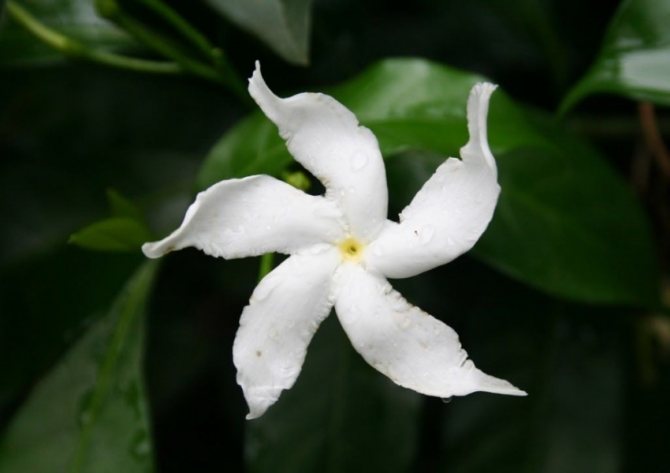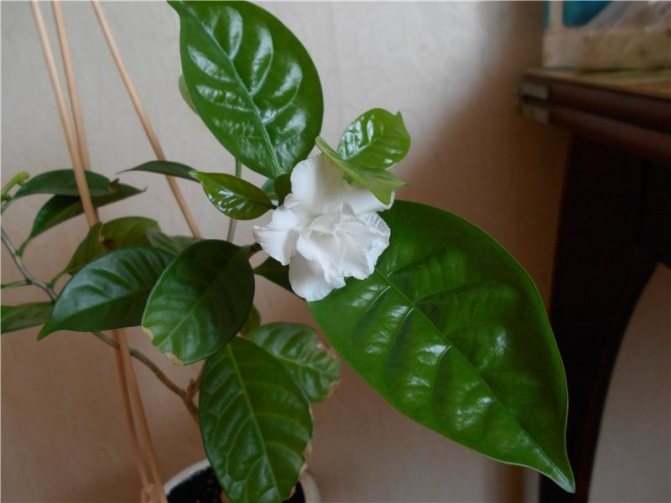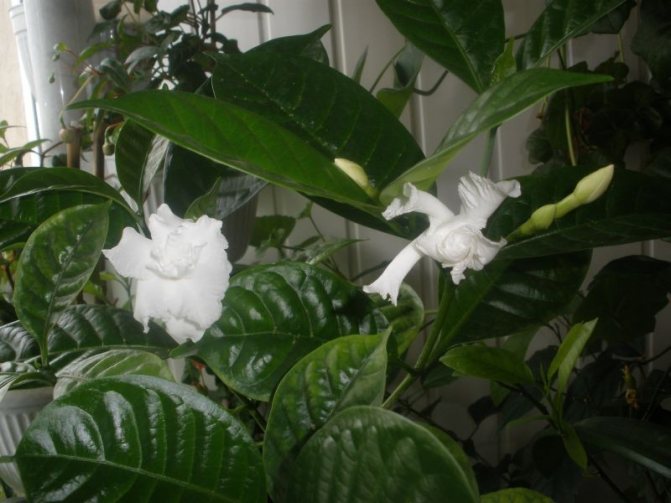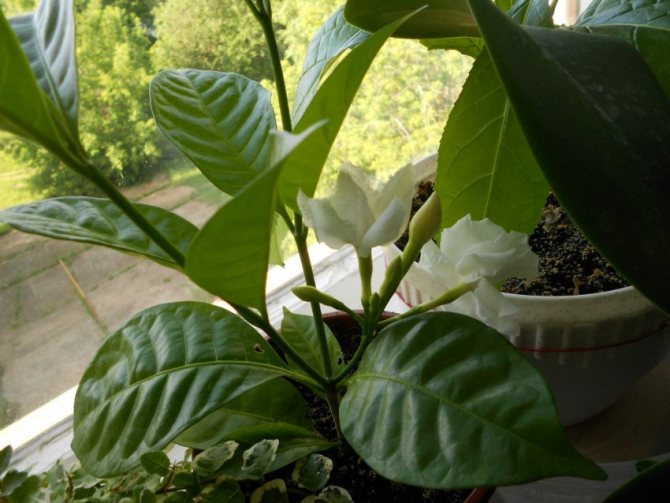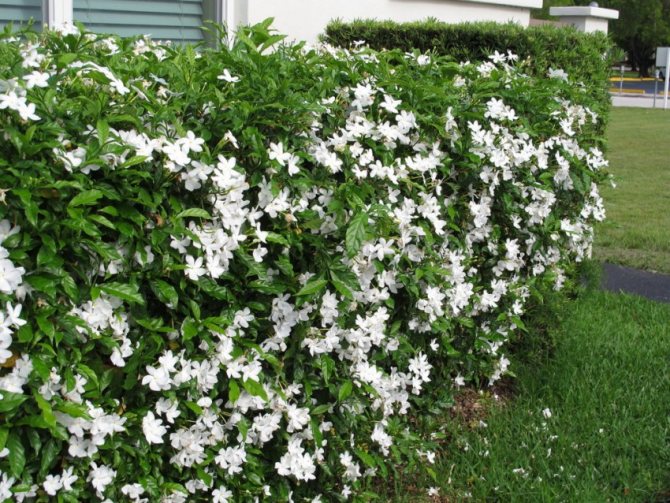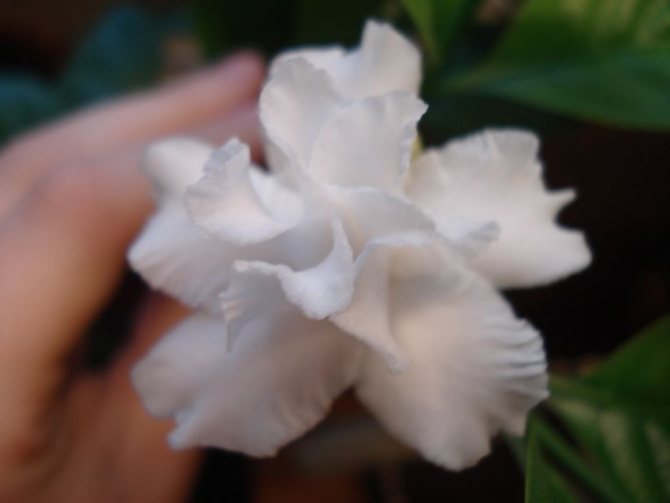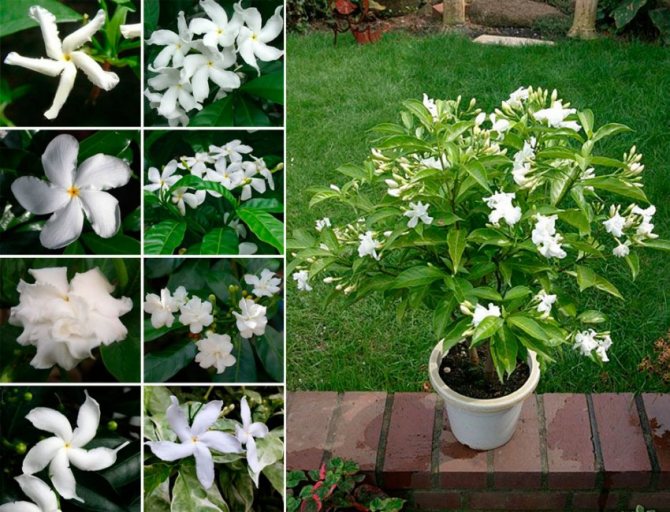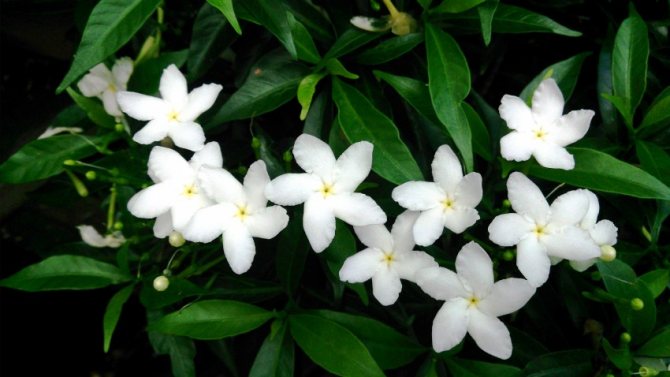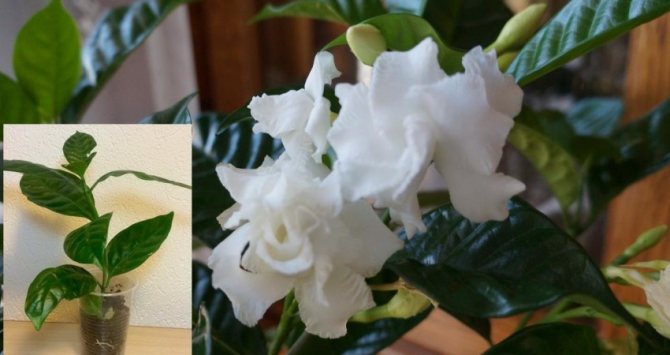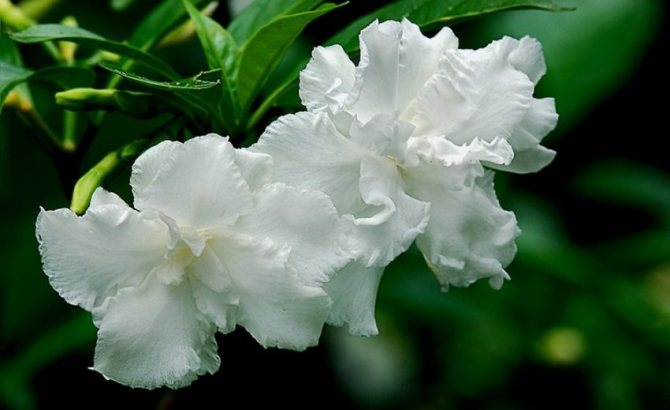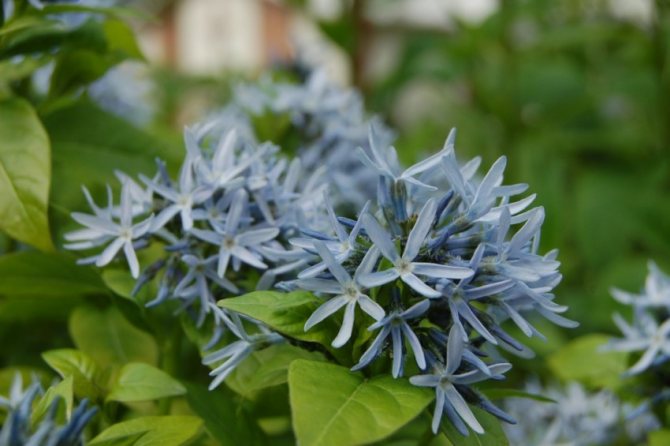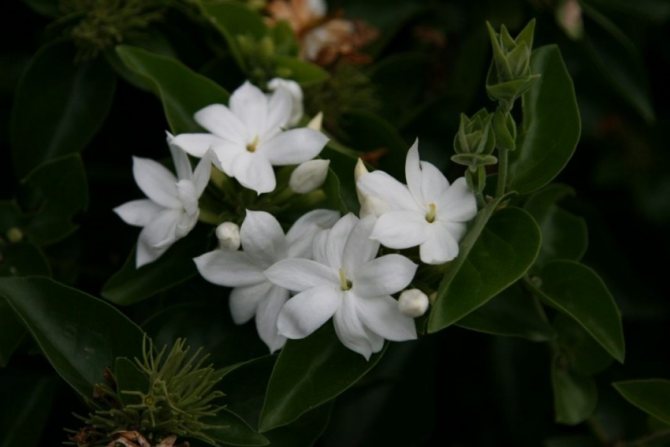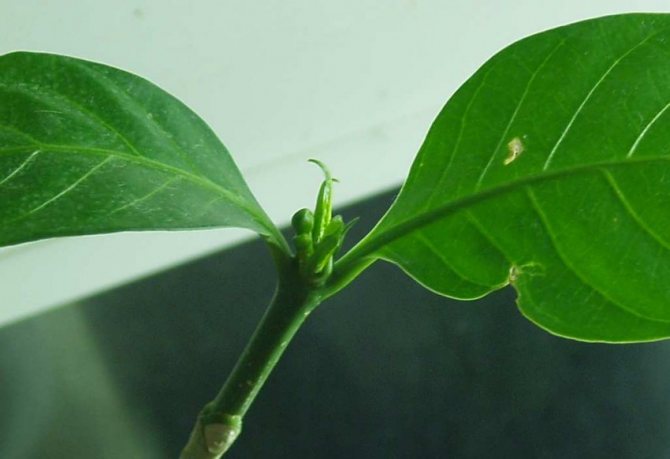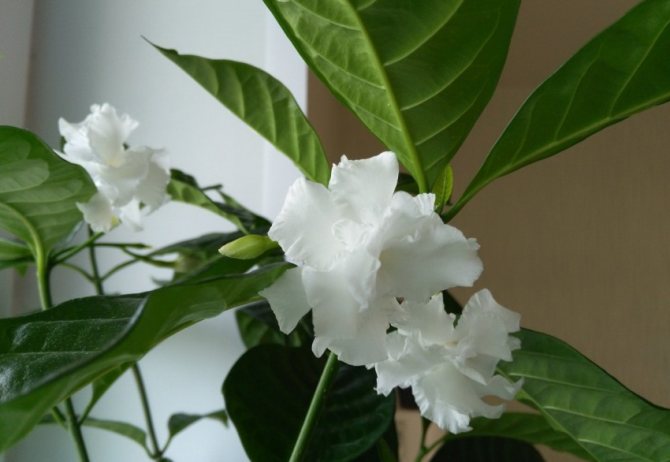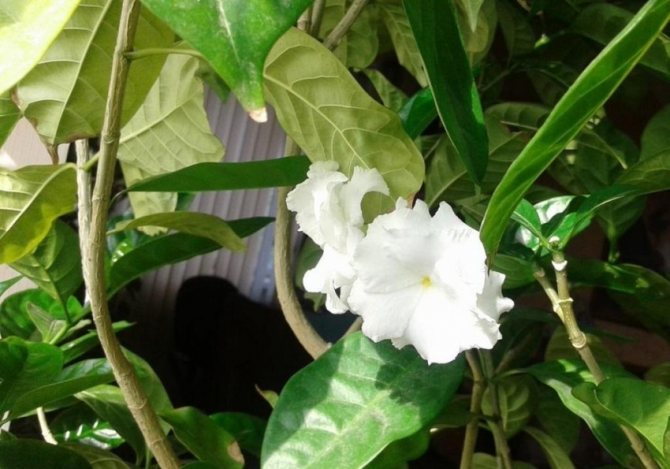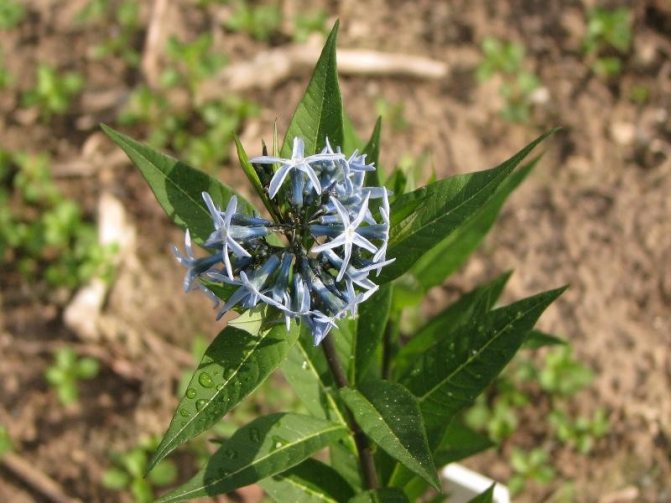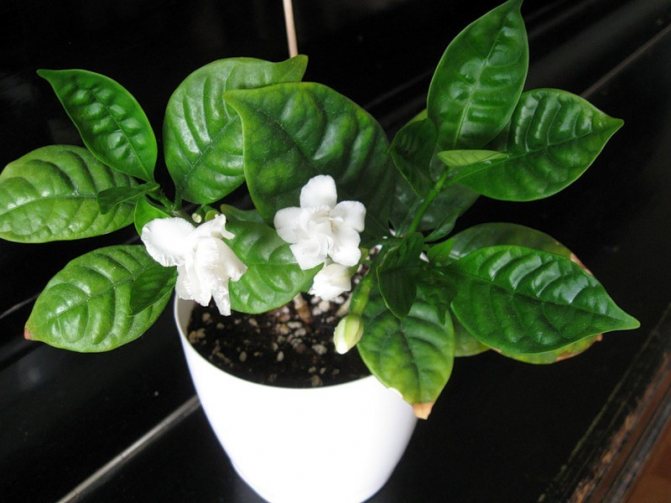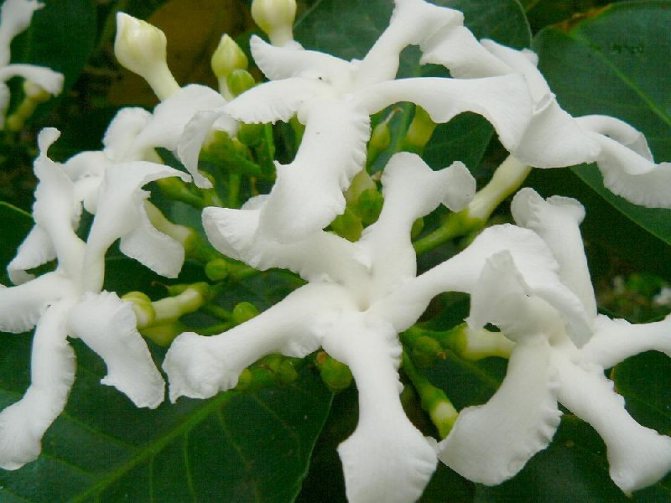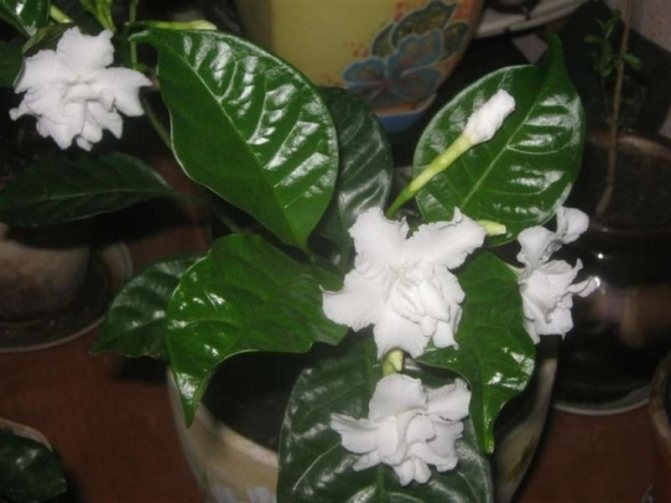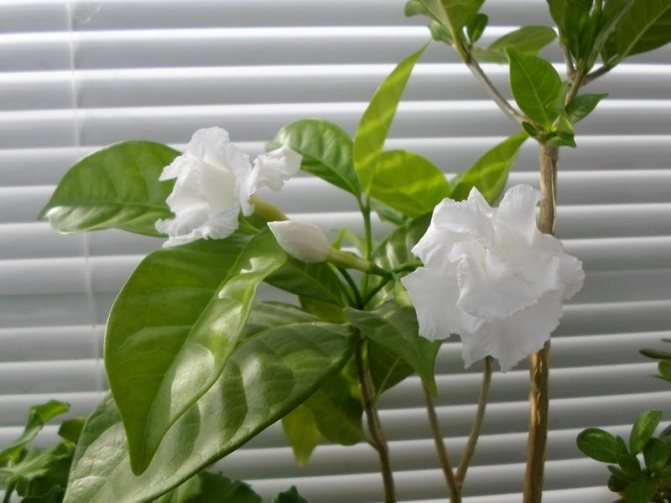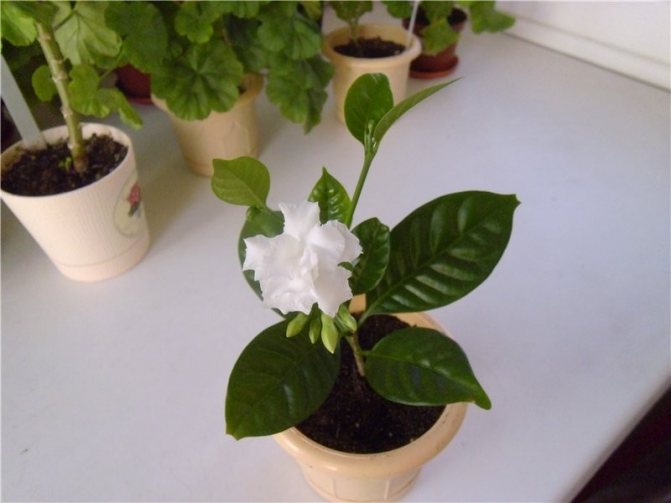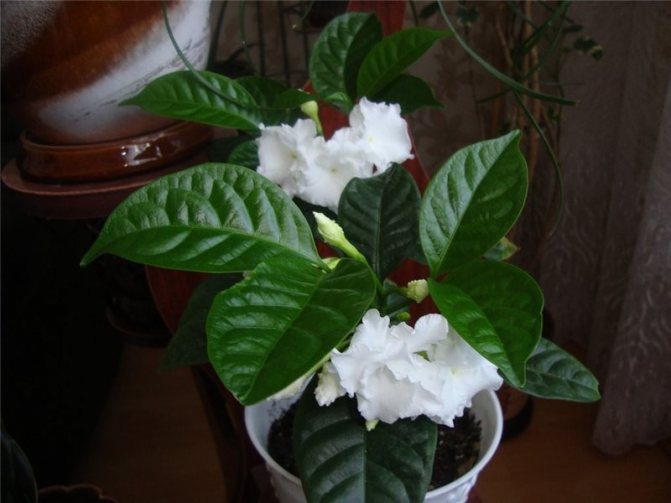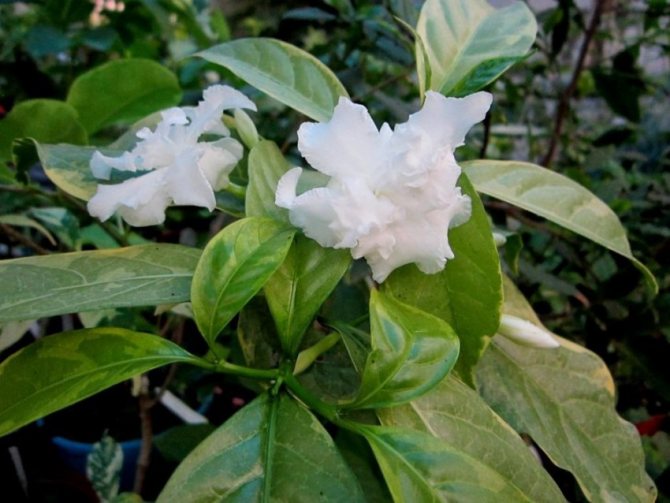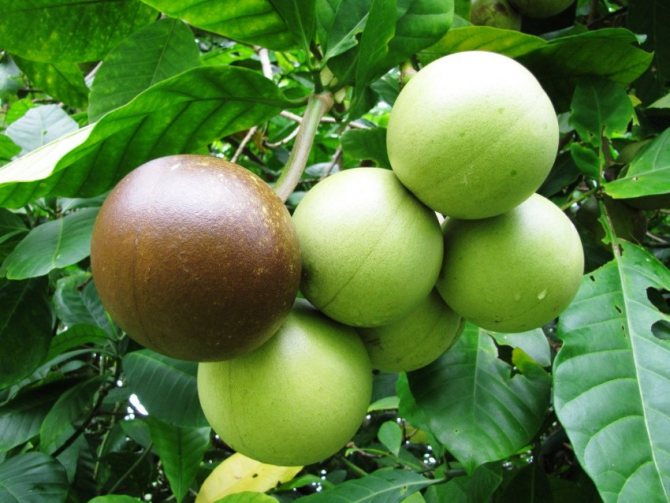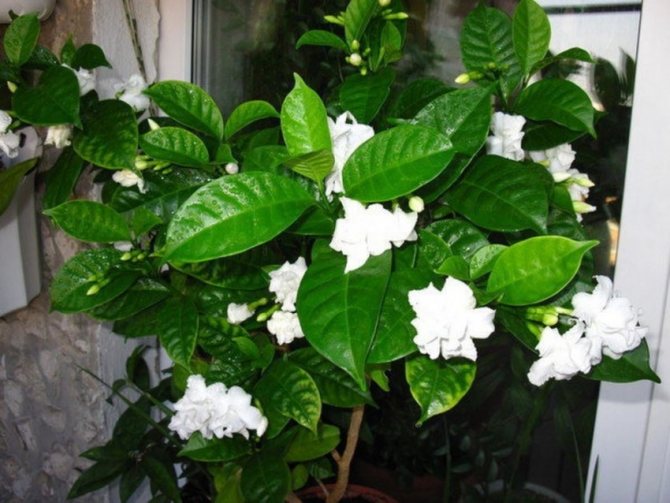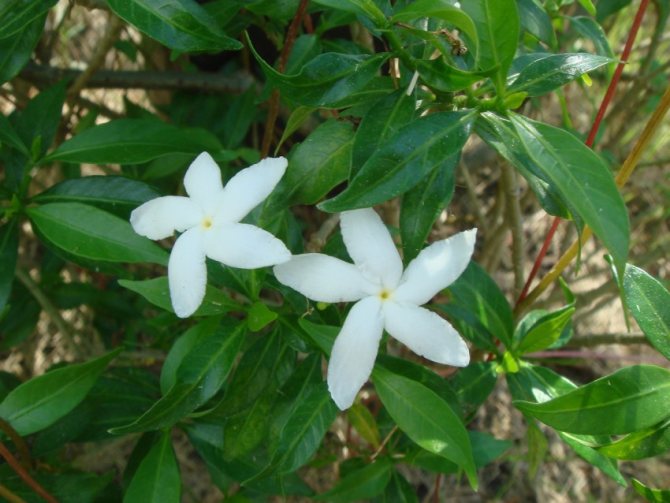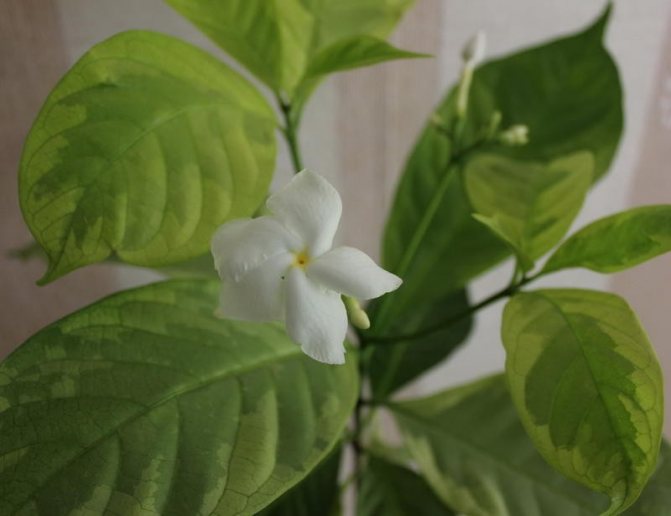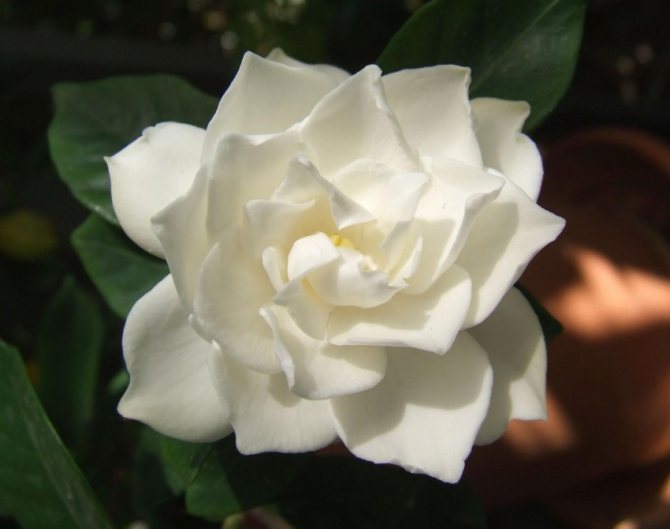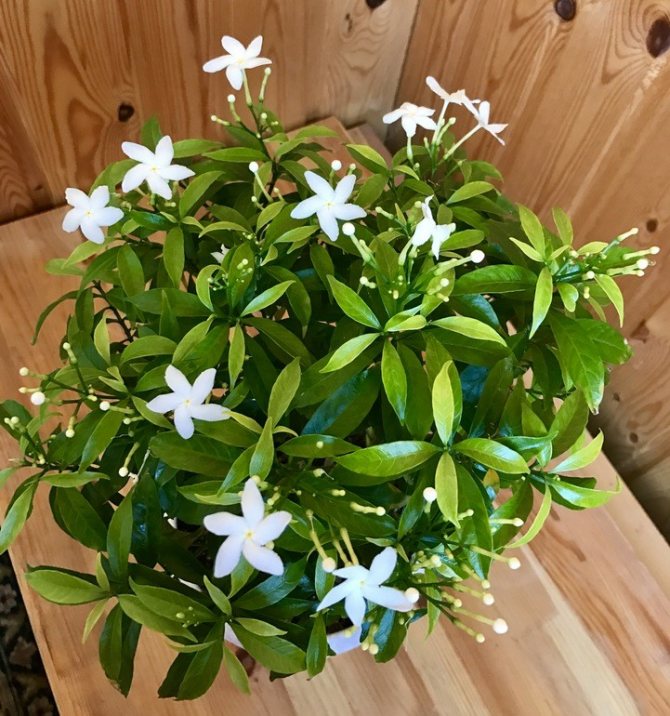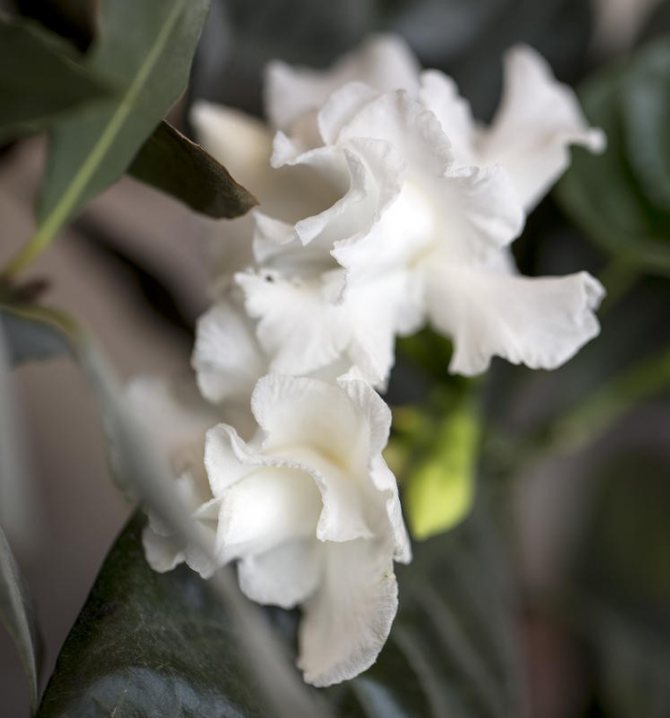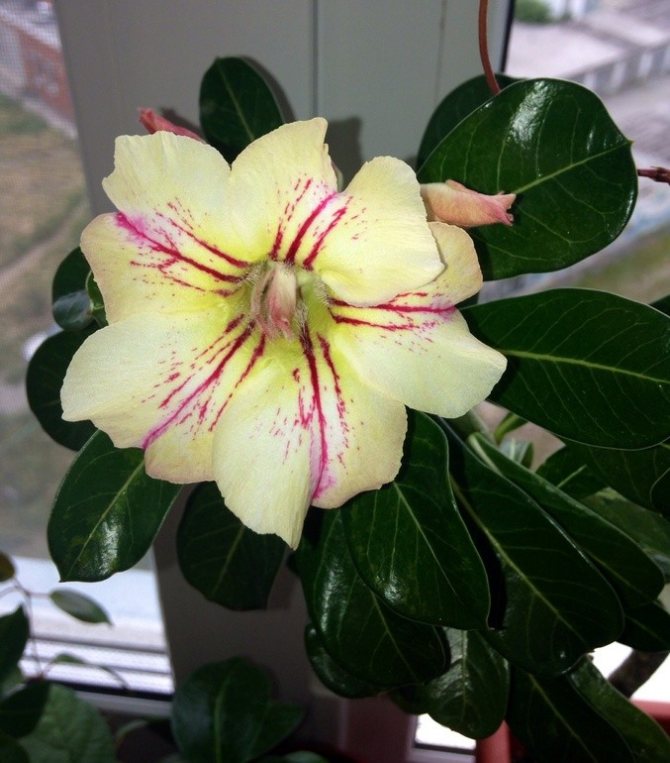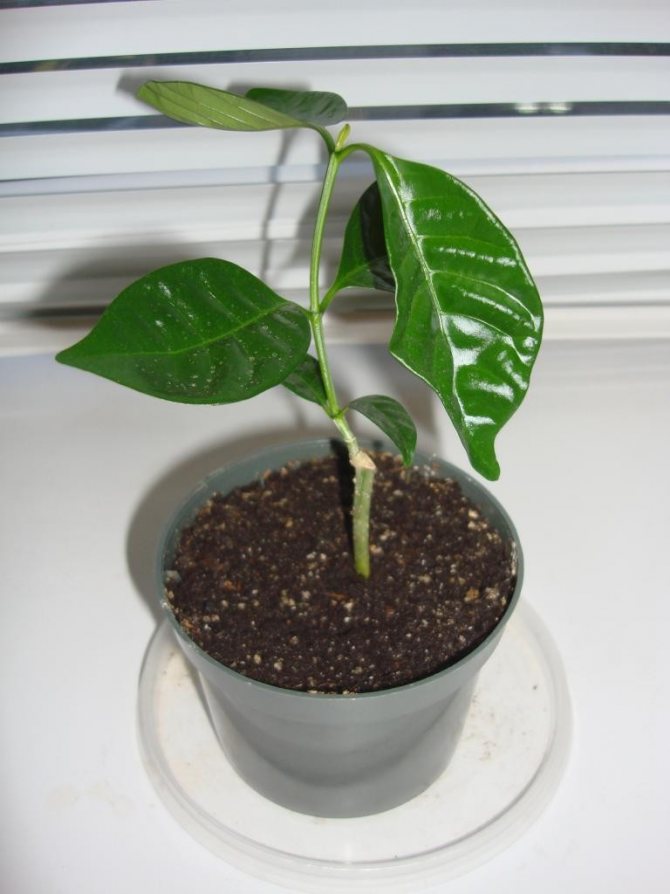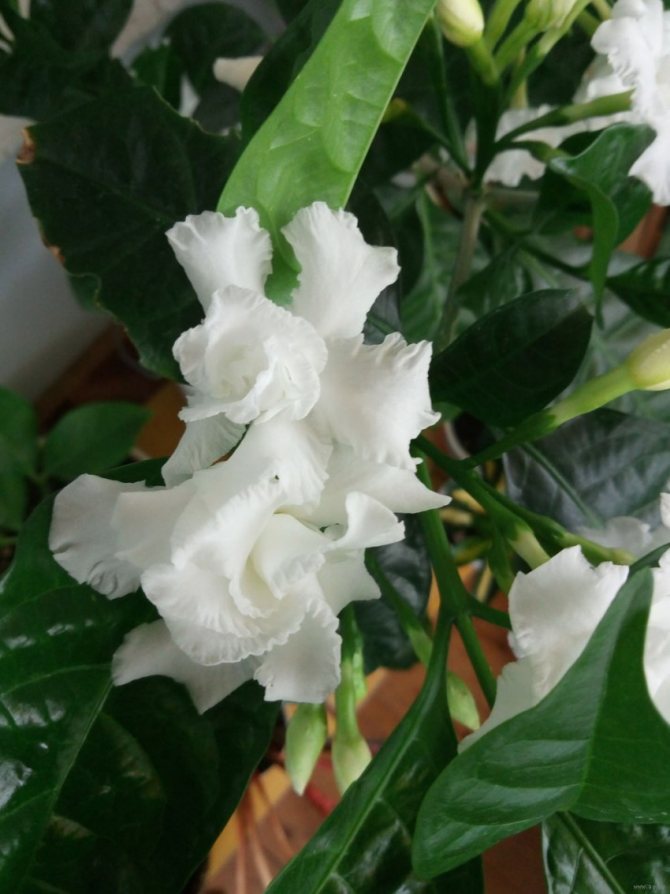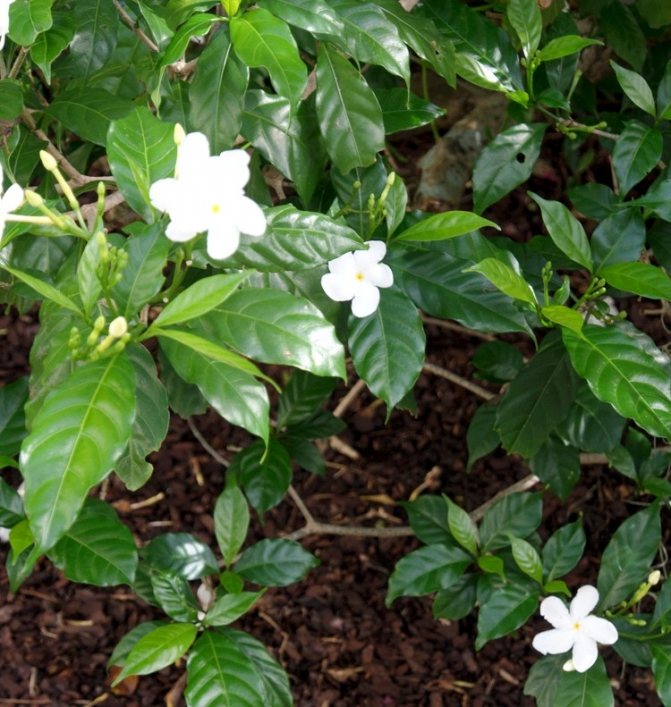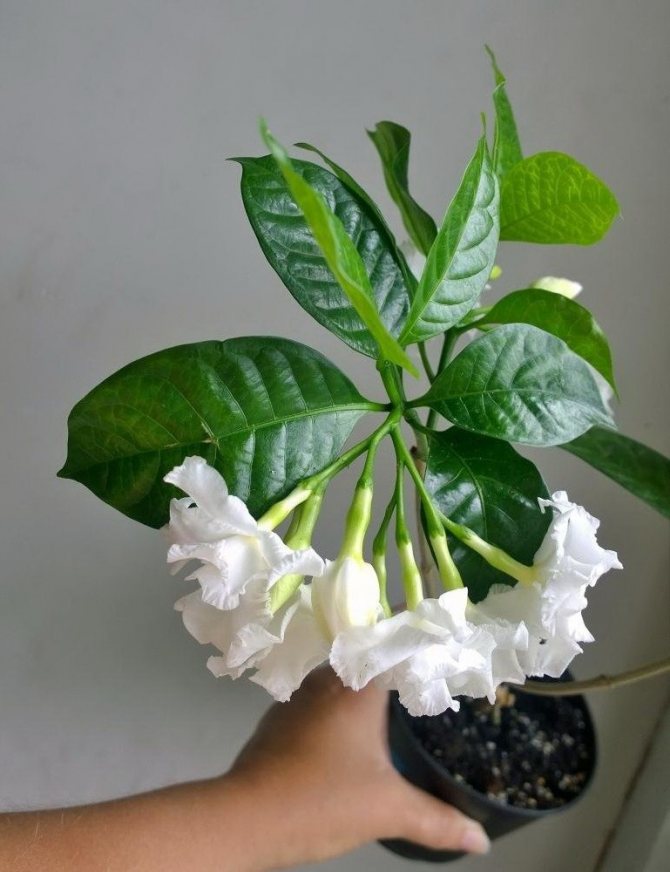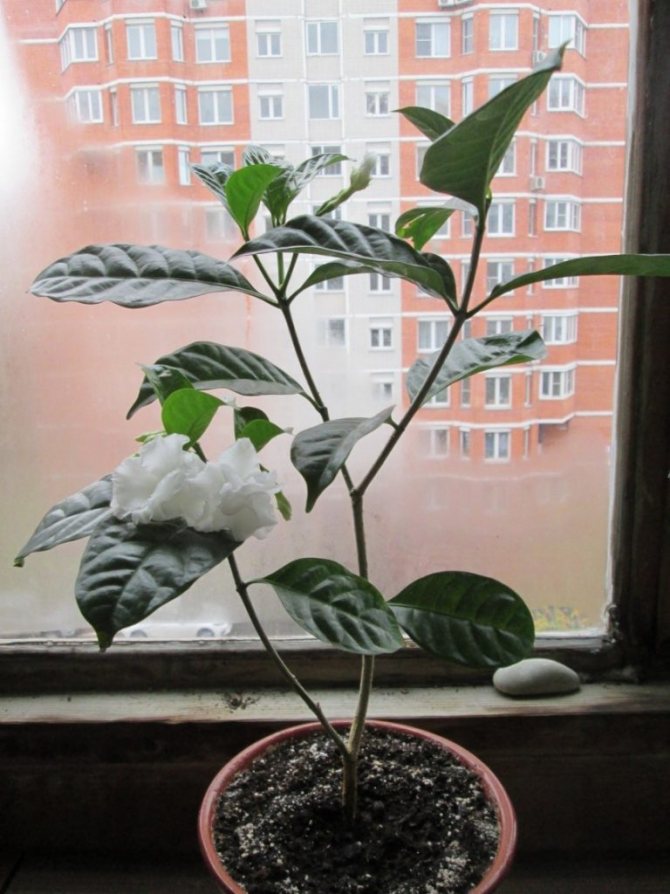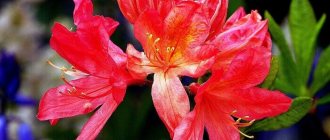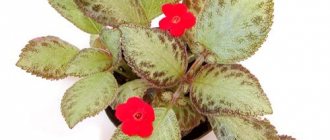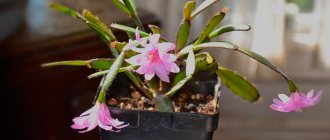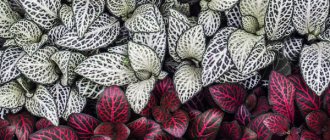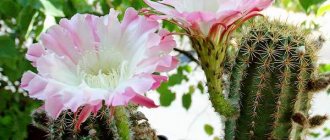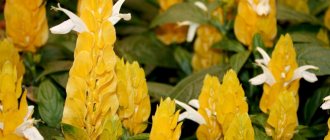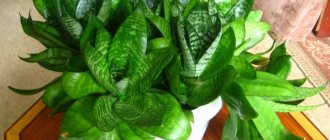Tabernemontana (Tabernaemontana) is classified according to the botanical classification to the Apocynaceae family. The place of its origin, this representative of the flora can be considered the territories of tropical Asia, but settling in other regions of the planet, it can be found on the lands of Central and South America, that is, where there is a tropical and subtropical climate. At the same time, it chooses coastal zones for its comfortable growth. The plant bears its scientific name in honor of the scientist who is considered in the scientific world as the "father of German botany" - Jacob Theodor Tabernemontanus. Thus, the French botanist Charles Plumier (1646-1704) decided to immortalize the name of his colleague at the beginning of the 18th century (in 1703).
All tabernemontans have a shrub or tree-like form of growth, while their sizes vary from small to medium. Parameters can vary from 40 cm to a meter or one and a half in height. The leaf plates on the branches are arranged in opposite order. The shape of the leaf is oblong with a pointed tip at the top, the surface is shiny and leathery. The foliage is painted green.
The flowers of the plant are its real decoration. Multiple buds are collected in an inflorescence that has the shape of a complex scutellum. In a flower, the calyx is divided into five parts, sepals are even in outline, small, usually they are thin films or thin-leaf-like structure, the apex is dull, the surface is glandular. The contours of the corolla are wheel-shaped, the size is often small, its color is predominantly white. Inside there are diverging anthers and a pistil with a cylindrical stigma. Apocarpous ovary with multiple ovules.
The size of the flower directly depends on the variety, so its length can reach 20 cm with an opening width of 3 to 5 cm. Often the structure of the flower is double, the color of the petals has a cream tone. The flowering process can be extended throughout the year.
With its outline of a bush and leaf plates, tabernemontana is very reminiscent of a gardenia, but only until the buds bloom. Gardenia is distinguished by a flower structure resembling a small rose and a rich pleasant aroma. The flowers of the first representative of the green world resemble the shape of a bell, with petals having a corrugated structure on their surface, and there is also a different, but also quite attractive smell.
After pollination, the formation of a fruit takes place, with which a large leaflet enters, inside with numerous seed material.
The growth rate of this excellent representative of kutrovy is quite high and it is recommended to restrain its size when grown indoors by pruning. If you follow all the conditions for care, tabernemontana will delight its owner for seven or more years.
Despite its resemblance to a very ornamental gardenia, the plant is not so demanding to care for. If we compare the rules for the cultivation of these representatives of the flora, then caring for the latter is quite simple, but with only some of the difficulties indicated below.
Ideal indoor plant - Tabernemontana
Home care brings real pleasure to amateur flower growers in handling such an amazing flower.
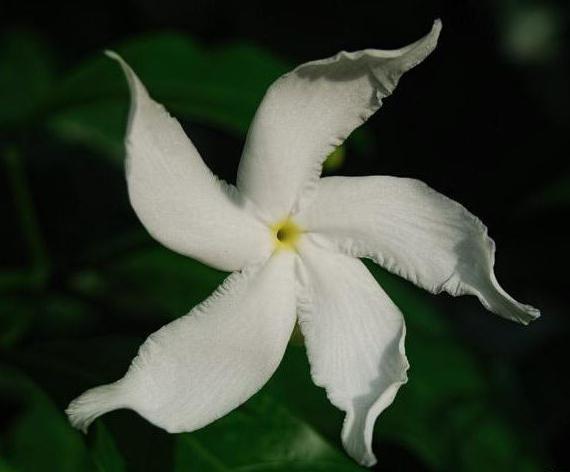
In indoor conditions, the plant, which is considered ideal for home cultivation for its flexible disposition and amazing beauty, can reach a height of up to 1.5 meters. Leaves are oblong, glossy, leathery, green, with pointed tips and interveinous protuberances. The average leaf size is 6-12 cm.
Tabernemontana, home care for which even beginners in the flower business can do, is loved by housewives for its abundant, almost year-round flowering. Its very peak occurs in the spring and summer. The snow-white double flowers resemble bells with corrugated petals, are characterized by a pleasant aroma, are about 4 cm in diameter, and are white or cream in color.
Curious notes about the tabernemontana flower


If you are not sure which representative of the flora in front of you is a gardenia or a tabernemontana, then, despite their external similarity (they belong to different families), the differences are the outlines of flowers. In the first plant, they resemble a rose (to some people, its appearance is represented by decorations on the cake), the same strong oily-looking petals with a smooth surface and the same milky or creamy outflow from the flower. When the buds of tabernemontana are dissolved, a bell-shaped corolla is immediately noted, and the surface of its petals has a corrugated structure. In gardenia, flowers generally grow singly, and only occasionally gathering a couple of buds together, the second representative of the green world pleases with corymbose inflorescences, in which the number of buds varies from three to 15 pieces. The color of the flowers does not change over the entire period, and the gardenia at first pleases with snow-white or cream tones of flowers, but over time they turn yellow.
There is another interesting test - in the gardenia shoots and leaf plates there is no milky sap, which is actively released when a branch or leaf is broken in tabernemontana.
Types of tabernemontana
Tabernemontana divarikata. The most common type of indoor flower. Treelike or bushy plant, strongly branched, with dark green leaves, glossy, opposite. On the reverse side of the leaf, the transverse veins are clearly visible. The branches are arranged horizontally, the fruits are pod-like, sometimes in a light speck, with juicy orange pulp. The aroma of white double flowers is persistent, sweet, similar to jasmine. Especially tabernemontana, which is easy to take care of at home, smells sweet at night.
The tabernemontana is elegant. A well-branching tree, inferior in size to the above-described Tabernemontana variety, with an indistinct aroma. Unpretentious in care: it easily tolerates frost and direct sunlight.
Crowned tabernemontana. The plant is richly branched, has shiny bright green leaves, reaching 12 cm in length. The inflorescence can contain up to 15 buds, the opening of which occurs gradually. Flowers with corrugated edges of petals, up to 5 cm in size, medium-sized, semi-double, are formed at the ends of the shoots. The aroma is exquisitely sophisticated, more noticeable in the newly opened flowers.
Flowers
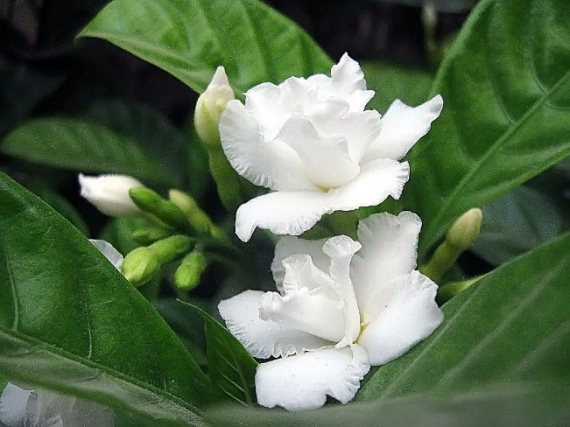

Tabernemontana (Tabernaemontana) is an evergreen flowering shrub of the Apocynaceae family, native to tropical and subtropical regions of America and Africa, as well as Southeast Asia. The plant grows mainly in the coastal area. Such a complex name was given to the plant by the German physicist and botanist J.T. von Bergsabern, who lived in the 16th century, and called it by his own name, translated into Latin. In the Russian interpretation, it can literally sound like a mountain tavern or mountain abode. Tabernemontana grows up to 1.5 m in height under indoor conditions.Leaves are green, glossy, leathery and oblong. The tips of the leaves are pointed, and the length of the leaf depends on the species and can be 7-20 cm in length and 3-5 cm in width. The diameter of the flowers is up to 4 cm, the color can be cream and white, terry, emit a pleasant smell. Tabernemontana blooms throughout the year. Tabernemontana is often confused with gardenia. Their leaves are very similar indeed. But once the flowers bloom and the differences immediately become replaced - tabernemontana flowers look like bells with corrugated petals, while in gardenia they are more like a rose.
Views
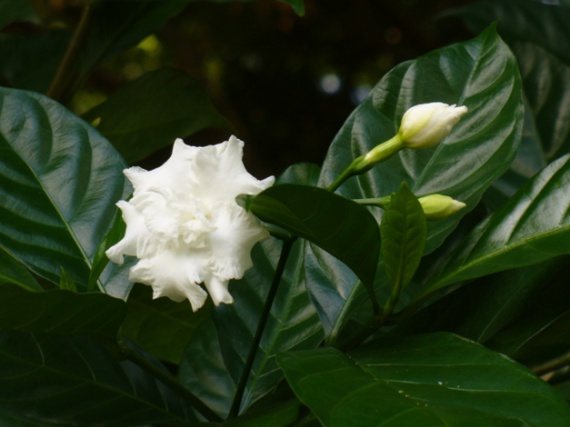

Tabernemontana Divarikata (Tabernaemontana divaricata) - evergreen, well-branched bushy or tree-like plant with large glossy, dark green opposite leaves, about 15-20 cm long, oblong, pointed at the end. The transverse veins clearly protrude on the reverse side of the leaf. The branches on the bush are almost horizontal. The flowers are white, the corolla is five-petal, the petals of the flower are slightly curved in a spiral, simple or double. The aroma of flowers is very persistent, reminiscent of the scent of jasmine, especially the aroma intensifies at night. The fruit is pod-like, dark green on top, smooth or wrinkled, sometimes with a light speck, the flesh is orange and juicy.


Elegant tabernemontana (Tabernaemontana elegans) is an evergreen well-branched tree, outwardly similar to Tabernaemontana divarikata, but somewhat smaller in size. It is less aromatic, but more unpretentious and more resistant to direct sunlight and frost.
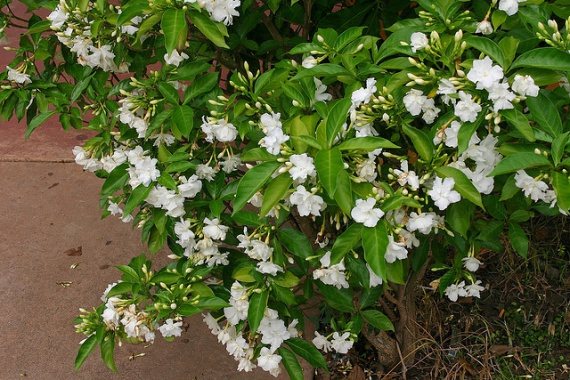

Tabernemontana topped (Tabrnaemontana coronaria) is a highly branched evergreen tree with shiny bright green oval leaves, with a pointed tip, 6-12 cm long and 5-8 cm wide. The leaves are convex between the veins, clearly standing out on the lighter back side. Flower buds are laid at the top of the shoot, while two lateral growth buds wake up at the same time. By the time of flowering, a pair of small leaves grows from these buds, and at the end of flowering, active growth of shoots begins and after 2-4 internodes flower buds are again laid and branches bifurcate. In the inflorescence there can be from 3 to 15 buds, opening gradually. The flowers are not large, from 3 to 5 cm, semi-double, with delicate, corrugated petals along the edge. The aroma is exquisite and delicate, the strongest in the newly opened flowers.
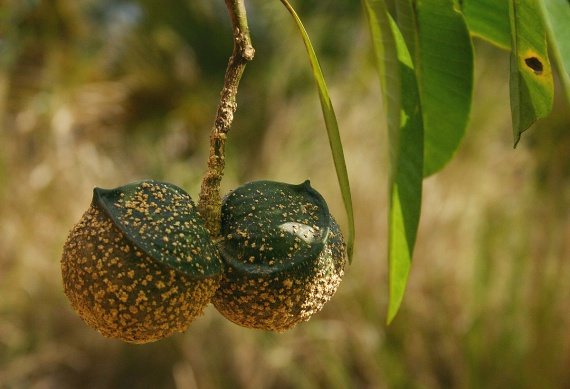

Lighting Tabernemontana prefers bright diffused lighting. West and east windows are well suited for growing.
Temperature Tabernemontana is a rather thermophilic plant, the optimum temperature is + 18-2% ° С. In summer, it feels good on the balcony or outside in the garden. In winter, tabernemontana can tolerate temperatures of at least 15 ° C. Afraid of drafts.
Air humidity Tabernemontana needs high humidity, although it can put up with dry air in city apartments, but still the plant must be sprayed periodically. Spraying is carried out with settled water. You also need to follow the rule: it is better to spray once more than to water.


Watering Tabernemontana is sensitive to waterlogging, so watering is moderate in summer and limited in winter.
Fertilizer In the spring-summer period, tabernemontana is fed 2 times a month with fertilizers for flowering indoor plants.


Transfer Young tabernemontana needs to be transplanted very often, even several times a year. Older plants are replanted every 2-3 years. The soil for transplanting should be sufficiently loose, and at the same time it is good to let the water pass through. You can mix a mixture of peat, leaf, humus earth, sand and perlite in equal parts.Tabernemontana needs good drainage. The plant grows well both in slightly alkaline and slightly acidic soil.
Reproduction You can propagate tabernemontana at any time of the year. To do this, cut off semi-lignified apical cuttings 8-10 cm long. The milky juice protruding on the cut must be washed off with warm running water to avoid blockage of the vessels of the plant. For better rooting, cuttings can be treated with root stimulants (Kornevin, Heteroauxin). The cuttings are planted in small pots, covered with a transparent bag or glass jar on top and kept at a temperature of at least + 22 ° C, regularly airing. The roots appear a month later or a little later. After the roots are entwined with a clod of earth, the plant should be transferred to a larger pot. Tabernemontana develops quite quickly and can bloom soon after rooting.


Diseases and pests The most common disease is chlorosis. Acidification of the substrate, treatment with iron chelate or ferrous sulfate, the introduction of trace elements helps. The most common pests are spider mites and scale insects. Sometimes tiny white droplets appear on the underside of the leaves, then drying and yellowing droplets. This is the secretion of leaf glands and they have nothing to do with pests. These droplets appear with excessive watering and with a sharp temperature drop, but they do not harm the plant at all.
In rooms with high temperatures and low air humidity, one can observe "sticking" and subsequent falling off of the buds that have not yet blossomed. greenhome
Lighting
The optimal development of a tabernemontana depends largely on the correct lighting, which must be bright but diffused. The ideal option would be to place a flower on the western or eastern side of the dwelling. On the southern windowsill, the plant will need shading. Tabernemontana, home care for which does not require special knowledge, can grow in the shade, but you should not expect abundant flowering with this arrangement. The plant reacts to the lack of light by dropping leaves.


Fresh air is very useful for the shrub, so in summer the flower can be kept on the balcony or in the garden. Tabernemontana is intolerable, care at home for which is absolutely not laborious, refers to drafts. During the budding period, the plant is not recommended to be rearranged to another place.
Conditions for planting amsonia plant
In open areas, the plant forms a compact bush.
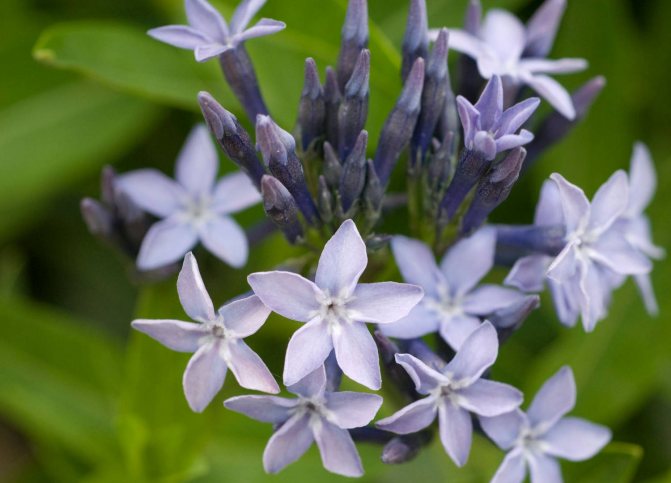

In the shade, amsonia grows spreading, it must be tied up.
A perennial should be grown on sandy or sandy loam soils. Before planting, you need to deacidify the soil and take care of drainage.
The plant does not tolerate stagnant moisture. The bushes grow rather quickly, so the distance between the seedlings should be 30 cm.
Winter care
For most plants, winter is a dormant period. At cool room temperature and natural light, it is necessary to reduce watering, spraying and feeding; if necessary, remove the buds. In other words, provide a rest regime before the onset of spring.
At a comfortable temperature (+ 18-20 ° C) in winter, you will need to make additional lighting for such an unpretentious and charming plant like tabernemontana. In this case, winter care is carried out as usual. Compliance with these conditions will lead to the abundant flowering of the tropical beauty throughout the winter.
Plant propagation
The flower is propagated by cuttings or seeds.
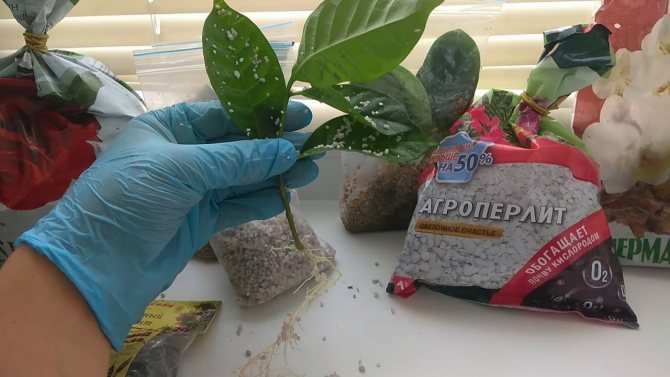

Reproduction
Cuttings
For the process of reproduction of tabernemontana by cuttings, you will need to cut off a twig 10 centimeters long. The planting material must be cut with a sharp knife. It is imperative to rinse the cut so that the vessels do not clog.The stalk is placed in warm water with activated carbon dissolved in it and covered with a bag. After a month, roots are formed.
Further, the process of formation of the root system is carried out. For this, the cutting is planted in a substrate made of peat and sand. After it becomes clear that the root system has completely covered the soil, the plant can be planted in a full-fledged pot.
Growing from seeds
The second way to grow a plant is preferred by botanists who are interested in what exactly can be obtained in the end. After all, it is known that with the seed method of reproduction, varietal characteristics are lost.
Watering and spraying is an important care factor
Coming from a subtropical area, tabernemontana, which is a real pleasure to care for, needs high humidity, so in city apartments, where the air is often dry, the plant needs to be regularly humidified. Water must be settled, melted or rainwater. Do not allow it to get on the flowers of the plant. Watering in hot weather and an abundance of light is preferable to abundant (immediately after the topsoil dries out) in summer, in winter - limited. With excessive moisture, the plant sheds its leaves and stops blooming.


For high-quality flower growth, nutritious soil is required. The key to good plant care is timely watering and frequent feeding.
If the edges began to peel off on the leaves, it means that the plant is experiencing a lack of water, nutrition, or the salinity of the upper soil layer is evident. The situation can be saved by replanting or renewing the upper earth layer.
Transplanting a Tabernemontana plant into a pot
Flower poultry farm Planting and care in the open field and at home Photo and description
Transplanting a tabernemontana will not be difficult. The main condition for this procedure is compliance with all recommendations.
What is needed for landing
Before you start planting a plant in a pot, you need to prepare everything you need. The soil is required light, loose, which can easily pass water. The acidity should be in the range of 4.5-5.5. If you make the soil mixture yourself, then coniferous and deciduous soil, river sand, peat and humus are taken in equal proportions. In the process of caring for a flower, a little lemon juice is added to the ground once a month.
The choice of the pot is of great importance. It is best if it is deep and wide enough. In no case should you take a spherical product or narrowed in the middle. Drainage must be placed at the bottom of the pot to protect the root system from waterlogging.


It is often necessary to transplant tabernemontana, since the bush grows quickly
Optimal location
In order for the tabernemontana to bloom and develop, you need to choose the right place where the pot will stand. Since the plant is completely undemanding, it can be placed on the windowsill or nearby. The length of daylight hours does not play a special role for the development of the flower. Five to six hours of daylight is enough for him to bloom and smell of flowers.
If the sun illuminates it for as long as possible, then the flowering will be more abundant. Therefore, it is best to put the tabernemontana on a window on the east or west side. If the flower is on the south side, then at noon it is recommended to cover it from direct sunlight.
Step-by-step planting process
The plant requires two or three transplants per year as it grows and develops rapidly. In the process, it must be borne in mind that the root system, although powerful, is quite fragile. Therefore, it is recommended to transfer it from pot to pot along with an earthen lump. The new pot must be a little larger than the previous one and filled with a quarter of new drainage. The procedure should proceed as follows:
- a plant is taken out of an old vessel along with soil, which cannot be shaken off;
- the bush is placed in a new pot for drainage;
- the root system is covered with fertile soil;
- the plant after transplanting is lightly watered;
- add soil if necessary.
Top dressing
Like any houseplant, tabernemontana will delight with lush flowering when applied to the soil. Their use is especially important during the period of active growth and development of the flower - spring-summer. For this, it is recommended to use a liquid mineral fertilizer for flowering plants, rich in phosphorus and potassium, which ensures long flowering.
Tabernemontana, care, reproduction of which at home is completely easy, will delight with lush flowering when introduced into the soil of 2 or 3-year-old bird humus. Fresh product cannot be used, as it negatively affects the root system. In the summer, the tabernemontana should be fed twice a month with fertilizer for flowering houseplants.


For the growth of leaves and stems, a mineral fertilizer for green plants is recommended. Fertilizing watering is best done in the evening. Dosage - according to the instructions. It should be remembered that an oversupply of fertilizer is much more dangerous than a lack of it.
What is a plant
Fatshedera home care and transplant
Tabernemontana is a plant native to Central and South America.
The flowers are white and beige, they are double and pleasant to the touch. There are many types.
Tabernemontana is not a very whimsical, evergreen houseplant, so it quickly finds owners for itself.
An interesting feature of the flower is that the scent increases with the onset of dusk and darkness.
Home care
1. The temperature in the room where Tabernemontana grows should be moderate. The plant should not be overcooled, as this can affect flowering.
2
The plant requires good lighting, which is very important to consider. On hot summer days, shade the plant to prevent the sun from burning the leaves.
3. Tabernemontana should be watered moderately, avoiding even short-term soil drought. When it is about half dry, then you need to water it again.
Water for irrigation must either be filtered or allowed to stand for a day. It should also be cool, but not cold. In summer, the plant needs to be watered more often, in winter, much less often.
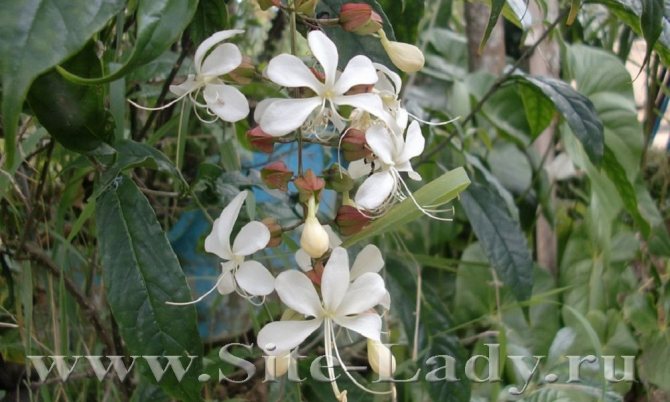

4
The air humidity should be increased, which is very important. You also need to arrange a warm shower for the plant, or wipe the leaves with a damp sponge.
If the air in the room is too dry, then the plant must be sprayed, but only with settled water. The water must be allowed to stand for a day.
5. The plant needs to be pruned to give it a beautiful shape.
6. You need to feed Tabernemontana with complex fertilizers, about once every two weeks. This will be enough and it will grow well.
7. Various pests can settle on the plant: aphids, scale insects, whiteflies and others. Onion or garlic decoctions will save the plant from them.
8. If the leaves are yellow and lethargic, then the reason is in violation of watering.
If the color of the plant begins to fade, the reason is not enough light.
If buds that have not yet blossomed begin to fall off, the reason is too high a temperature, or low humidity.
If the leaves fall off, do not worry, as the plant gets rid of the old ones. On the back of the leaves, you can see small white drops, which then begin to turn yellow.
This process does not apply to diseases, so you should not worry. This is the release of a substance by leaves, which appears as a result of strong watering and a sharp drop in air temperature. Moreover, this process does not harm the plant at all.
Signs and superstitions
1. Positive action.
If the plant grows in the house of an unmarried girl, then most likely she will find her love. If in the house of a married woman, then it will save her from adultery.
The plant absorbs negative energy, giving positive energy. It charges people with positive, can bring harmony and understanding to the family.
2. Negative action.
The plant can bring trouble to the family. It can also embroil loved ones and destroy a family. Homeowners can be plagued by setbacks in personal life or financial well-being.
Tabernemontana will decorate your home and become an exclusive element of interior decor.
Flower on "T", 14 letters.
Reproduction
The tabernemontana flower, which even an inexperienced person can take care of, multiplies at any time of the year. When propagating by cuttings, an apical or semi-lignified shoot about 10 cm long with 2-3 internodes is used. The stalk is cut at an oblique angle; the juice released during cutting must be rinsed in water to avoid clogging of the stomata. For guaranteed root growth, it is recommended that the cutting of the plant be kept in a growth stimulator ("Heteroauxin", "Kornevin" or "Zircon") for a day.


Cuttings must be planted in small containers, covered with a glass jar or a transparent bag on top. The temperature of the content is about 22 ° C, regular ventilation is mandatory. The roots appear in about a month. After they braid a clod of earth, the tabernemontana needs to be transferred to a flower pot by transferring. The plant develops very quickly and can bloom almost immediately after rooting.
Reproduction of amsonia
Perennial reproduces well in all available ways.
Gardeners note that new plants are produced well with cuttings. Young amsonia will bloom in the third year of life.
Seeds
After flowering, cylindrical fruits are formed on the stems, which are 10 cm in length.There are large seeds inside them.
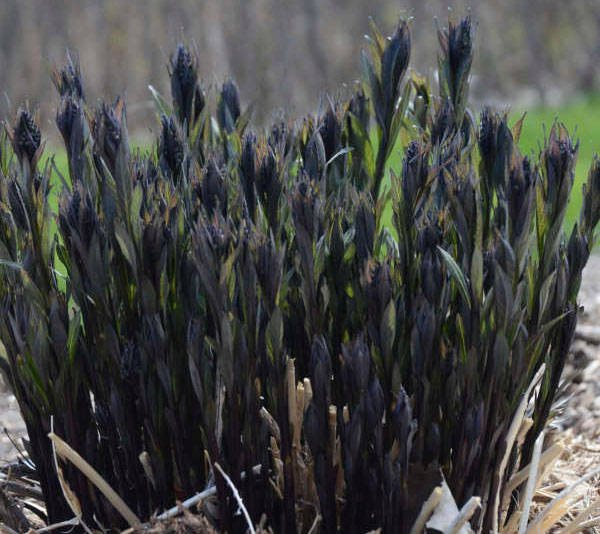

The fruits are harvested in September, the seeds are immediately sown on the garden bed, which is then covered with lutrasil.
With the onset of stable heat in the spring, the covering material is removed.
At first, seedlings develop slowly, but by autumn they can be transplanted to a permanent place.
Purchased seeds need stratification. Containers with planting material are sent to a refrigerator or cellar for two months.
After this time, the containers are placed on the window, after which the seeds will sprout quickly.
Cuttings
Cuttings from the apical shoots are cut in the first half of June. Sections are powdered with wood ash or kept in Kornevin's solution.
After that, the cuttings are planted in a pot with a nutritious substrate; a layer of river sand can be poured onto the surface.
Roots form quickly; by the fall of this year, the matured cuttings can be planted in a permanent place.
By dividing the bush
Overgrown bushes are divided both in spring and autumn. Amsonia has strong lignified roots, so efforts will be required from the gardener.


Sometimes the bushes have to be sawed.
Each section should contain 3 buds.
When planting, the root collar should be above ground level.
Amsonia without transplants and division can grow in one place for 10 years.
Transfer
Tabernaemontana, whose care consists in regular watering and periodic feeding, needs frequent transplantation of young plants - up to several times a year, adults - once every 2-3 years. The soil for these purposes should be well water-permeable and loose.
A composition of peat, sand, perlite, leaf and humus earth, combined in equal parts, is best suited. Also, a plant with a well-developed, branched root system needs good drainage. The roots quickly fill the space of the pot, so the flower will have to be transplanted quite often.At the same time, the transfer capacity should not be several times larger than the previous one: a gap of 2-3 cm is enough.
Amsonia in landscape design
The perennial is ideal for nature-style gardens.


Badan, marsh geranium, marigold and bathing suit are combined with amsonia. Small varieties are often planted in a strip along lawns and paths.
The bushes are used in rockeries and mixborders. Neighbors in these compositions are tulips, phlox, stonecrop and hosts.
Amsonia is often used to decorate artificial reservoirs, composing compositions with astilbe, fern, brunner, calamus and sedge.
CherryLink plugin not found
Pests and diseases of the tabernemontana plant: care
Leaves turn yellow. This symptom indicates the defeat of the plant by chlorosis, which can be combated by acidifying the substrate, treating the soil with iron chelate or ferrous sulfate and introducing useful microelements. Also, the flower often suffers from scale insects or spider mites.
Occasionally, tiny white droplets are observed on the underside of the leaves, later yellowing and drying out. These are secretions of leaf glands that have nothing to do with pests. This sign indicates excessive watering or a sudden temperature drop.


At low air humidity in the room and high temperatures, you can observe the sticking of buds that have not yet blossomed, which subsequently fall off. In a young specimen, flowers may fall off with an abundance of buds.
Diseases and pests of amsonia
The plant is resistant to common ailments, however, stagnant moisture in the area can provoke root rot.
Its main symptoms include wilting and drying of leaves, brown spots and lodging.
Deeply damaged plants will have to be disposed of.
The disease is easier to prevent, for this you need to take care of the drainage layer, and periodically spill the soil with a solution of "Fitosporin".
Ornamental plantings are susceptible to aphid attacks.
A malicious pest settles on the stems and the underside of the leaves.
Aphids not only suck out the juice, but are also a carrier of infectious diseases. In this case, Amsonia should be treated with Tanrek, Aktara or Lightning insecticides.
Often, a thin cobweb can be found on the stems and leaves, which indicates a spider mite lesion. Brown spots appear on the leaves, buds and flowers die off, and the bush itself grows very slowly.
After detection, it is necessary to remove the damaged leaves, weed out all the weeds around the plantings. Amsonia bushes are treated with Iskra, Aktellik or Kleschevit.
The shield can do a lot of damage. The stems and leaves of the affected plant are covered with dense scales. Brown spots form on the damaged areas, which lead to death.
It is difficult to exterminate the insect, because its body is covered with a dense chitinous shell. You will have to remove the scabbards manually.
The bushes are sprayed with Aktara solution twice, it is recommended to spill soil on the flower bed. The treatment interval is two weeks.
Site selection and ground requirements
Amsonia loves sunny areas where it forms dense lush bushes. In the shade, it stretches, the branches fall, the plant looks sloppy. A perennial can grow in one place for a very long time, it grows slowly, and feels good in one place for up to ten years. Therefore, you need to carefully consider the choice of a landing site.
The plant prefers a well-drained, loose soil, responds well to liming. Grows well on fertile loose sandy loam.
Fertilizer
Top dressing is applied to wet soil once every two weeks. Fertilizer is applied to flowering plants.


Important! It is recommended to occasionally water the soil with acidified water with the addition of a few grains of citric acid.
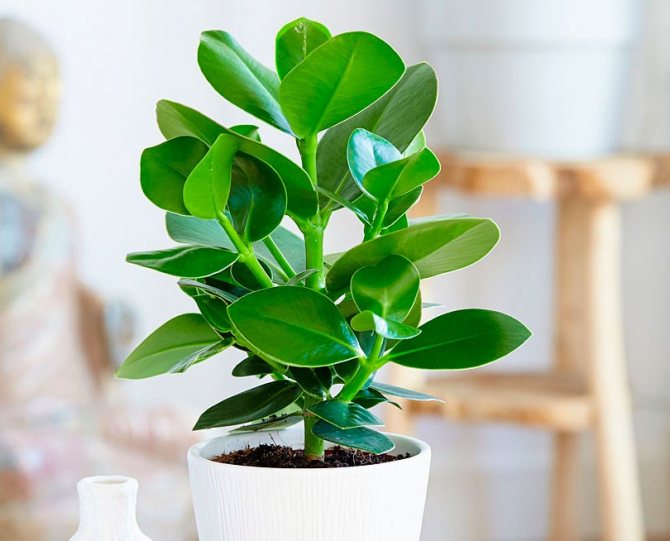

Lighting and temperature control
The thermophilic tabernemontana grows well and develops in bright, diffused lighting.It is recommended to place it on the windowsills of the western or eastern side of the apartment. Does not tolerate drafts.
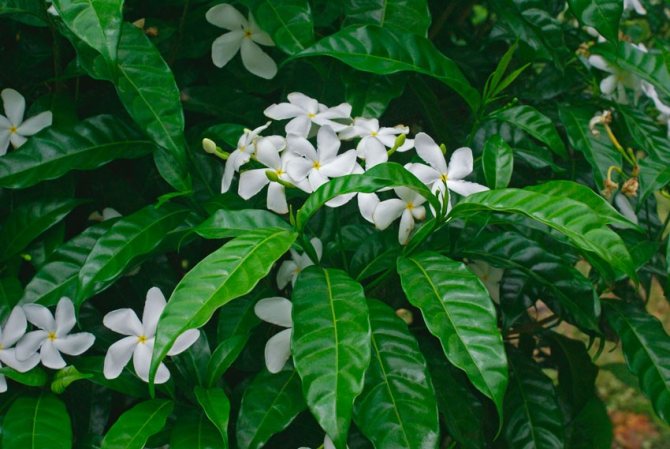

The optimum temperature for it is considered to be + 18-25 ºС. Resistant to summer heat with regular moistening of the earthy coma. In winter, it is not advisable to lower the temperature below +15 ºС.
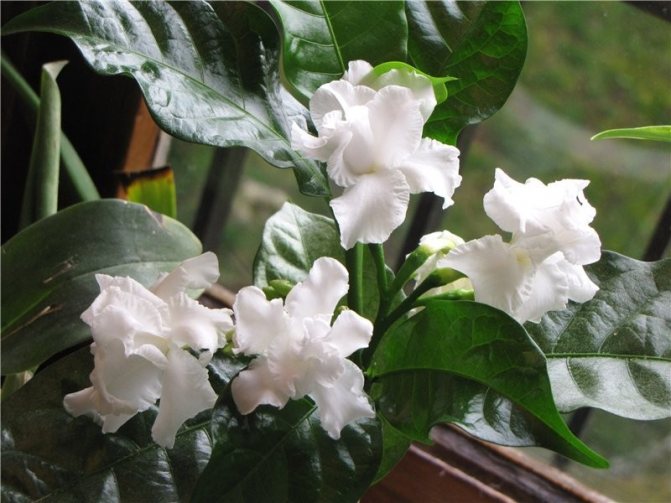

Growing problems:
- Blanching of the color of the leaves, stretching of the shoots indicates that the plant suffers from insufficient lighting;
- Whitish, yellowish droplets on the seamy surface of the leaves are a natural process for the release of substances from the leaf glands. Such a process can be triggered by waterlogging of the soil and a sharp change in temperature;
- Buds fall off if the room is too hot and low humidity. If this happens in a young plant, then the reasons may lie in insufficient fertilization;
- The lethargy of the shoots, yellowing of the leaves indicates that the plant has undergone overflow and most likely the root system has begun to rot;
Views: 97
Insects are pests
Unfortunately, the plant is very sensitive to pests sucking its juice. When they appear on Tabernemontana, the leaves turn yellow, the flowers crumble, the bush stops growing and looks lifeless. Spider mites, mealybugs, aphids, scale insects, whiteflies love to feed on the juices of this tropical guest. It is very difficult to get rid of sucking parasites. First of all, wash the diseased plant in the bathroom under a warm shower - this will wash off most of the pests from the plant with water. When the flower dries up, treat it with one of the insecticides: Aktara, Bi-58 New or Fufanon. Read the instructions carefully. After processing, place the plant in a large plastic bag and seal it in it for several hours - the effect on insects will be higher. Then take the Tabernemontana out of the bag and place it in a well-lit place, but isolated from healthy plants, observe it. Most likely, you will not be able to get rid of all the insects at one time, and the insecticide treatment will have to be repeated more than once - with an interval of 7 to 10 days.
Formation of the crown of the tabernemontana at home:
The plant responds well to formative pruning, which can be done all year round. even during flowering. Tabernemontana can be shaped to almost any desired shape. For this, even the most radical pruning can be done, because it recovers quickly enough and lets out young branches. Most often, flower growers grow tabernemontana in the form of a neat bush and a small tree. Pruning helps to achieve sufficient density and splendor for the plant.
All broken, diseased and growing inward shoots, shoots that are too elongated and thinned, are pruned. During flowering, all buds that have faded must be removed in time.
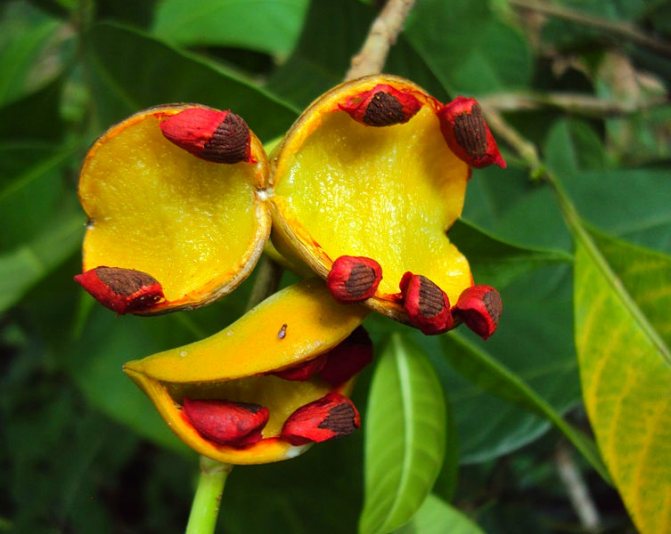

Tabernaemontana alternifolia. <>
Botanical description of the plant
Tabernemontana is an ornamental tree-like shrub belonging to the Kutrovs. It is found in Sri Lanka, Singapore, Thailand, India, tropical regions of Africa, South and Central America, where it is popular as a street shrub in coastal areas.
Home tabernemontana has an attractive appearance. It looks like a shrub or a short tree with many thin branches. Its height usually does not exceed 1–1.5 m. The stem of a young specimen is rather fragile; as it matures, it stiffens and becomes covered with light bark. Oval-shaped light green leaves (8–10 cm) with sharp ends are attached to it with the help of short, thick petioles. If you try them by touch, then you can feel dense bulges between the veins.
Did you know? The unusual name was given to the flower by the botanist Bergsabern from Germany, who used the Latin version of his own name.
In spring and summer, snow-white spiral-shaped flowers with double petals, 3-15 pieces per inflorescence, appear.Blooming, the plant fills the room with a wonderful aroma, which is confused with jasmine. The end of flowering is marked by the appearance of greenish fruits with juicy orange pulp.
Tabernemontana lives for more than 7 years, and with proper care it can bloom all year round with short pauses.
| Root system | compact |
| Stem | arboreal |
| Leaf shape | oval |
| Leaf color | dark green |
| Flower shape | spiral |
| Flower color | white |
| Fruit shape | pod |
| Fruit color | dark green |
| Fruit taste | inedible |
Photos of tabernemontana
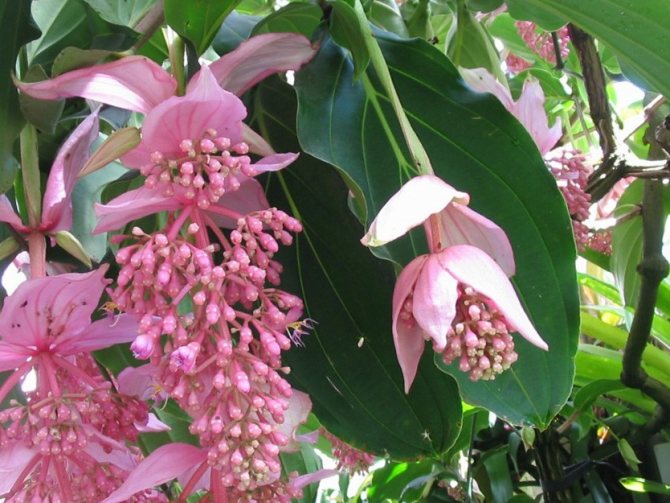

Medinilla - care secrets and tips on how to grow a flower at home

Home begonia - planting, care, cultivation and reproduction of domestic flower species
- Chrysalidocarpus - secrets of care and rules for keeping at home
Watering
Waterlogging of the soil is detrimental to the plant. But light drying is easy to tolerate. Therefore, watering should be moderate.
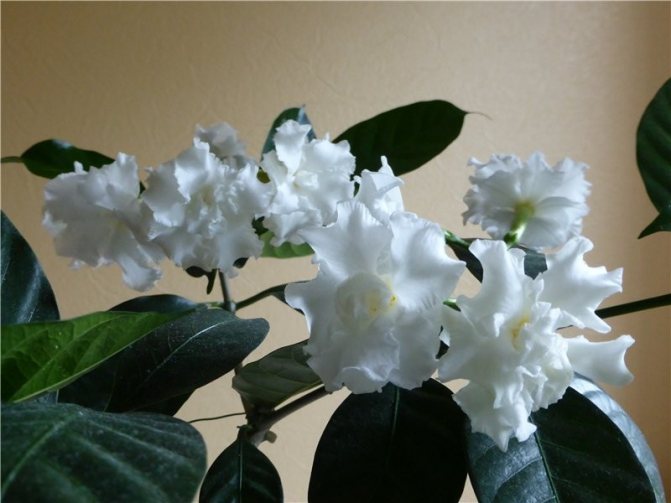

Tabernemontana loves high humidity. It is advisable to spray the plant 2-3 times a week. You can install a stationary humidifier in the room. Use separated water. Leaves should be wiped with a damp sponge.
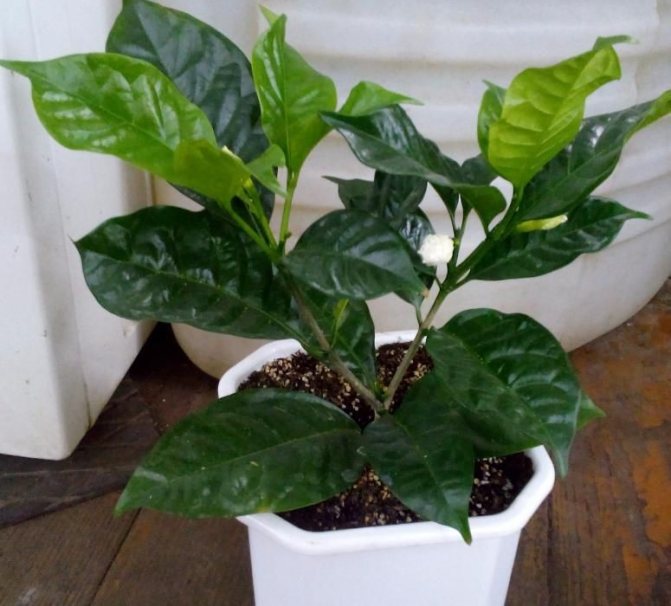

Care
Amsonia is undemanding to fertilizing, spring mulching of the soil with humus is enough for it. He loves watering with warm water and washing the leaves, but does not tolerate stagnation of moisture in the ground. It is recommended to trim off faded flower brushes if seeds are not needed. Self-seeding is undesirable, this will lead to excessive thickening of the bush.
For the winter, the stems are cut to a height of 10 cm. Amsonia willow can be left uncovered, it usually hibernates well under the snow. If severe frosts are expected, but there is no snow, you can cover the plantings with agrotechnical cloth or an armful of straw, cover them with sawdust.
The soil
The soil is chosen loose, with good air permeability, with a neutral or slightly acidic reaction. Overflow or sand is added as a baking powder. The soil is perfect for azaleas or citrus fruits. Expanded clay is used for drainage, which is used to fill a quarter of the pot.
Problems
The shrub can be attacked by pests: whitefly, mealybug, scale insect or others. For the fight, you can use folk or modern means. For example: onion and garlic broth or tobacco infusion. Chemicals: insecticides.
With improper care of tabernemontana, its leaves turn yellow. This common bush disease is chlorosis.
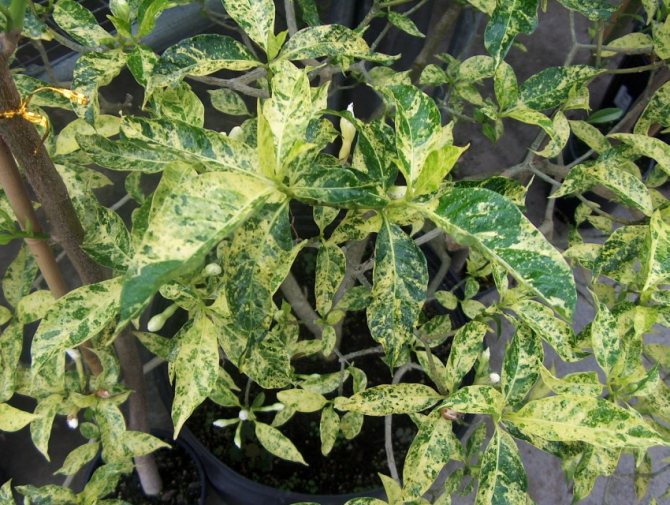

In this case, the plant can be cured with iron chelate, which can be purchased ready-made or prepared on its own. It can also help to cope with the disease and treatment of leaves with the universal remedy "Emerald".


Despite minor difficulties in growing tabernemontana, an exotic shrub is able to decorate any home corner and constantly give a wonderful unique aroma.
Care errors and their elimination
Common problems when growing a plant and methods for their elimination:
| Problem | The reasons | Decision |
| Pulling out shoots and pallor of leaves | Lack of lighting | Move the pot closer to sunlight or provide additional lighting |
| Bonding of unblown flowers, their falling off | Low humidity, high air temperature | Spray the plant regularly, place the pot in a tray with wet expanded clay |
| Slow growth, no buds | Cramped pot | Transplant the flower into a larger container |
| Leaf delamination | Lack of moisture and nutrition | Regulate watering, make complex fertilizing |
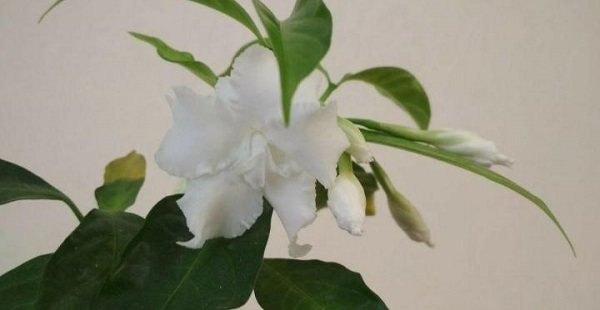

The origin of the plant
The name of the flower is very difficult to pronounce, but despite this drawback, flower growers are happy to acquire it. It resembles a gardenia to some, jasmine to others. Tabernemontana reed has nothing to do with any of these plants. The name was given to him in honor of Jacob Theodor Tabernemontanus.
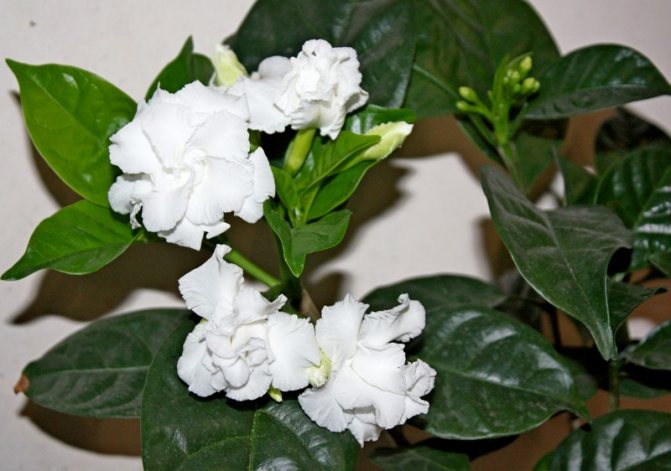

Blooming tabernemontana pleases the eye
The homeland of the flower is Central and South America, where locals call it "the flower of love". Over time, it began to spread throughout the world. The tree is most often grown indoors. In countries where the air is humid and warm, tabernemontana is an ornamental plant that grows in gardens. In America, pest control agents are made from parts of the shrub, added to drinks, the fruits of certain varieties are eaten.
3. Varieties:
3.1 Tabernemontana divaricata or spread out - Tabernaemontana divaricata
A multi-stemmed flowering shrub with profusely branched, thin, flexible stems that form a rounded crown. Leaves are dark green, oblong-lanceolate, whole-edged, glossy, with branched veins, on short petioles, arranged in opposite pairs. The flowers are white, with a yellow center, with five oblong petals, collected in small apical inflorescences. Plants reach a height of 1.5 - 3 m.
↑ Up,
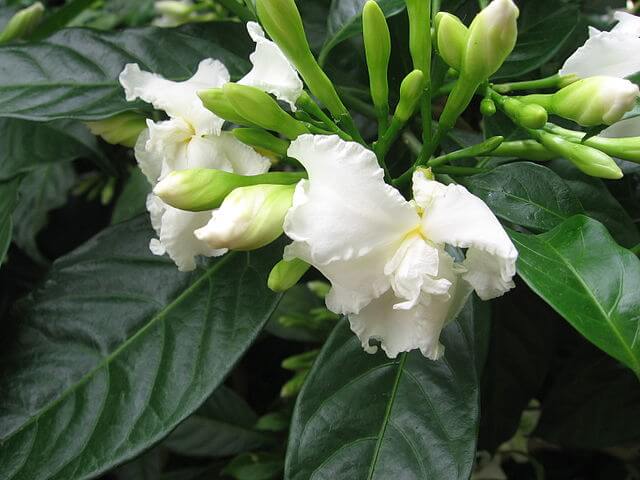

3.2 Tabernaemontana Super Silver
Blooming, variegated shrub, with narrow, lanceolate, entire leaves, the surface of which is covered with a silvery bloom. The flowers are white, solitary, appear on the tops of the shoots.
↑ Up,
Features of seasonal care
Tabernemontana can grow and bloom almost all year round. But continuous flowering takes a lot of energy from the plant and it loses its attractiveness over time. Therefore, in winter, it is advisable to provide the flower with a period of relative rest in order to give it a rest and gain strength. The temperature is lowered to + 15..18 degrees. The number of waterings is reduced. Top dressing is applied only once a month, the tree is sprayed once a week.
If you want the tabernemontana to continue to bloom in winter, care for it continues as before. It is important to avoid sudden changes in temperature and not to allow it to fall below + 15..16 ° C. Arrange additional lighting using fluorescent lamps or phytolamps.
Caring for tabernemontana at home
Growing tabernemontana at home
Compared to gardenia or related oleander, the tabernemontana flower is much less whimsical, but its cultivation has its own characteristics. Like any tropical plant, tabernemontana requires a high level of lighting, so it should be placed on the west, east, or southeast side. Morning direct sunlight is beneficial for the plant, but in the afternoon it is better to shade the flower from the sun so that the leaves do not get burned. In poor light, tabernemontana can get sick or refuse to bloom.
In the photo: Growing tabernemontana at home
The comfortable temperature range for tabernemontana in spring and summer is 17-22 ˚C, although it can withstand even more intense heat without losing its decorative effect. The plant enjoys spending summer holidays on the balcony or in the garden. In winter, it is advisable to lower the temperature of the content to 15-16 ˚C. The lower limit is 12 ˚C, but it is better not to keep tabernemontana for a long time in such conditions. Protect the plant from drafts during the cold season. It is also impossible to allow a sharp temperature drop in the room.
- 13 ways to use aloe for health and beauty
How to grow catharanthus on the windowsill and in the garden
Watering and feeding tabernemontana
Tabernemontana does not tolerate even a short-term drought, so its watering must be timely. Between waterings, the substrate should dry out to half the depth. In the summer, the soil is moistened 1-2 times, in the winter - once a week. Do not allow the earthen coma to dry completely, otherwise the tabernemontana will fade.
Tabernemontana comes from regions with a humid climate, therefore it needs high air humidity, which is achieved by spraying the leaves from a fine spray: large drops falling on the petals will leave stains on them.The procedure is carried out 2-3 times a week in the hot season and once a week in winter.
To increase the humidity in the room, you can use a household humidifier or wash the tabernemontana under the shower from time to time.
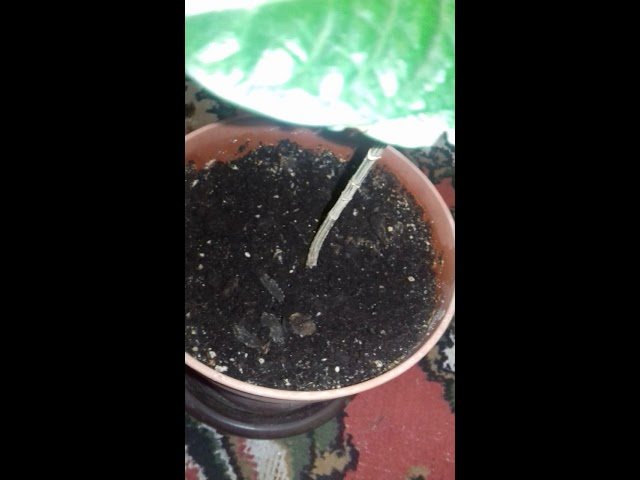

Both for irrigation and for spraying, you need water at room temperature passed through a filter or standing for a day. Once a month, a few crystals of citric acid should be added to the water for irrigation.
Tabernemontana is fertilized with mineral complexes for flowering plants once every two weeks, and in order for the leaves of the plant to always be glossy and bright, liquid nitrogen fertilizer Emerald is added to the substrate.
Pruning tabernemontana
You can prune tabernemontana at any time of the year: the plant recovers very quickly, so it can be given any shape. For sanitary purposes, it is necessary to remove growing in depth, broken and overgrown shoots and branches, and formative pruning can be used to make a neat bush or tree with a stem from the tabernemontana. Pruning stimulates the tillering of tabernemontana, making its crown thicker and more magnificent.
- Tradescantia - care, photos, views
How to grow a periwinkle - a detailed guide
Soil for tabernemontana
The substrate for tabernemontana should be loose, nutritious, slightly sour (pH 4.5-5.5). You can grow it in ready-made potting mixes for citrus or azaleas purchased at a flower shop, to which you should add a handful of sand, or you can make your own substrate from equal parts of peat, coniferous, leafy, humus earth and sand.


In the photo: How tabernemontana blooms
Transplantation and reproduction of tabernemontana
One of the few difficulties in growing tabernemontana at home is the need for frequent plant transplants. Young tabernemontans have to be transplanted 2-3 times a year, but for adult flowers, you can change pots and substrate once every 2-3 years. The transplant is carried out in February by the transshipment method, which does not destroy the earthen clod on the roots of the plant. The new pot should be 3-4 cm larger than the previous one.
The drainage layer should occupy at least a quarter of the pot's volume. After transplanting, you should reduce the watering of the tabernemontana and stop feeding for one and a half to two months.
Tabernemontana propagated by seeds and cuttings. Seed reproduction is a very laborious and long-term method, therefore, it is used mainly by specialists or amateurs with extensive experience. Tabernemontana seeds are germinated under diffused light at a temperature of 18 ˚C. Seedlings may appear in about a month, and tabernemontana from seeds will bloom in two years.


Cutting allows you to get a new plant in a shorter time than growing from seeds implies. You will need healthy, mature shoots 8-12 cm long with two to three pairs of leaves. The cuttings are cut at a right angle, the milky juice that has emerged on the cut is washed off, the cut is treated with a rooting stimulator and placed in water or a substrate for rooting.
In the first case use filtered water with charcoal or activated carbon dissolved in it. The stalk, placed with a cut in water, is covered with a plastic bag to create conditions for high humidity for it.
In the second case for rooting, a peat-sand mixture is used, which is placed in a plastic container with a transparent high lid. The stalk is slightly buried in moistened soil and, to create a greenhouse effect, cover the container with a transparent lid. Once a day, the bag or lid should be removed for a few minutes for airing, and the substrate should be kept slightly damp at all times. Tabernemontana takes root in an average of 1-2 months, and seedlings from cuttings bloom in the first year.
- Gardenia home: care, reproduction, transplant
Popular varieties
Among the varieties that are grown on the territory of Russia, the following are the most common.
Amsonia Habrichta
The most unpretentious and winter-hardy variety. It blooms with light blue inflorescences up to 10 cm in diameter, collected in lush domes, from the end of May (and in warmer regions from the middle) to the end of June. Needle-shaped saturated green leaves up to 8 cm long are located tightly to each other, fall late, burning out for a long time in the autumn garden with a bright golden "fire". Has an increased immunity to rot and other diseases.
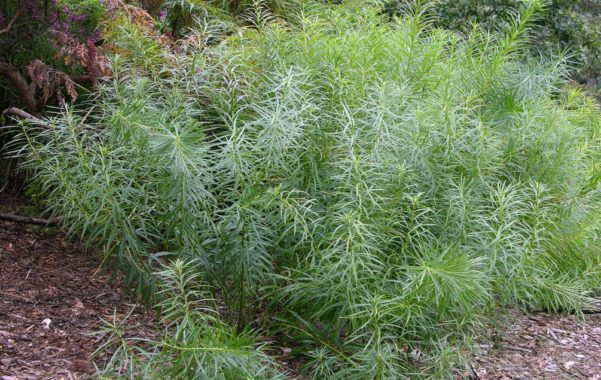

Amsonia Tabernemontana
Another relatively undemanding to heat and completely unpretentious in terms of growing conditions, a variety native to the states of Texas and Florida in the United States. It grows both on waterlogged soils and on rocky ground. Tabernemontana also tolerates shady places well, but the most natural, as for other varieties of this culture, are well-lit areas for it. The buds effectively combine blue petals and deep blue tubular pharynx. For safe wintering, it is enough to sprinkle with snow in time.
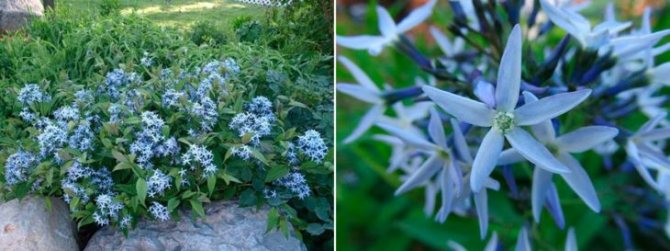

Amsonia eastern
A very demanding Mediterranean variety to weather conditions, therefore it cannot be found in Russian gardens, but it can be grown in a greenhouse. Throughout the entire cycle of annual development, it constantly changes its appearance.
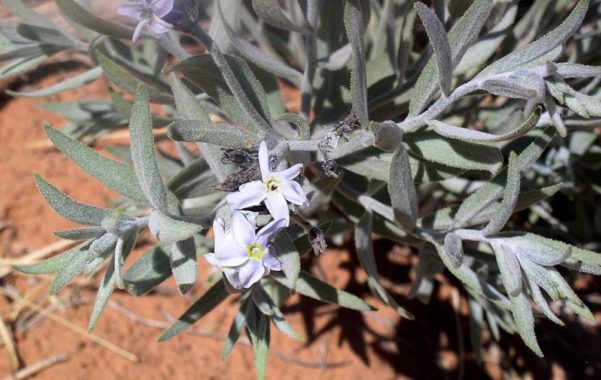

Amsonia Ciliated
Compared to other common varieties, it has more pubescent stems and less dense inflorescence caps, which makes it look like a flowering herringbone. The height of the bush is average, about 60cm. It does not tolerate the cold well.


Willow
It owes its name to the external similarity of the shape of the leaves and long elongated stems with the willow. Unlike other varieties, it has a strong woody root. Tall variety, reaching 1m. Flowers are rarely planted, do not crumble in the rain and from the wind, decorate the bush for about a month. They can be used for cutting vases and composing Provence style compositions.


Which variety to choose
In the climatic conditions of Russia, only the most unpretentious and winter-hardy varieties can be grown. In the fourth climatic zone (minimum temperature drops to -23C), Amsonia willow leaf or tabernemontana is successfully grown. In the fifth (up to -29C), it is recommended to plant Amsonia Habricht, however, it will need a winter shelter. The most thermophilic varieties of culture are ciliated amsonia and, especially, eastern.
Russian breeders, unfortunately, are not yet engaged in the production of seeds of this exotic on a commercial scale, so today you can buy amsonia seeds only on the appropriate sites that offer delivery by mail.



